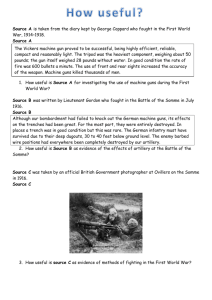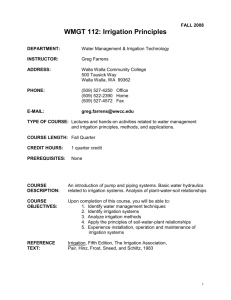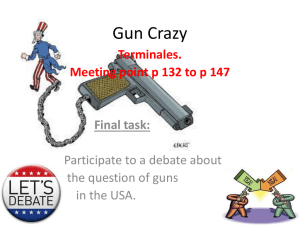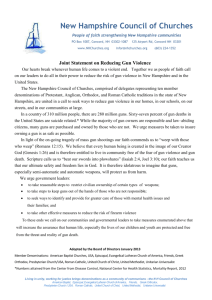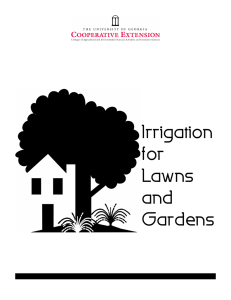Irrigation Options Big Guns - Delta Conservation District
advertisement
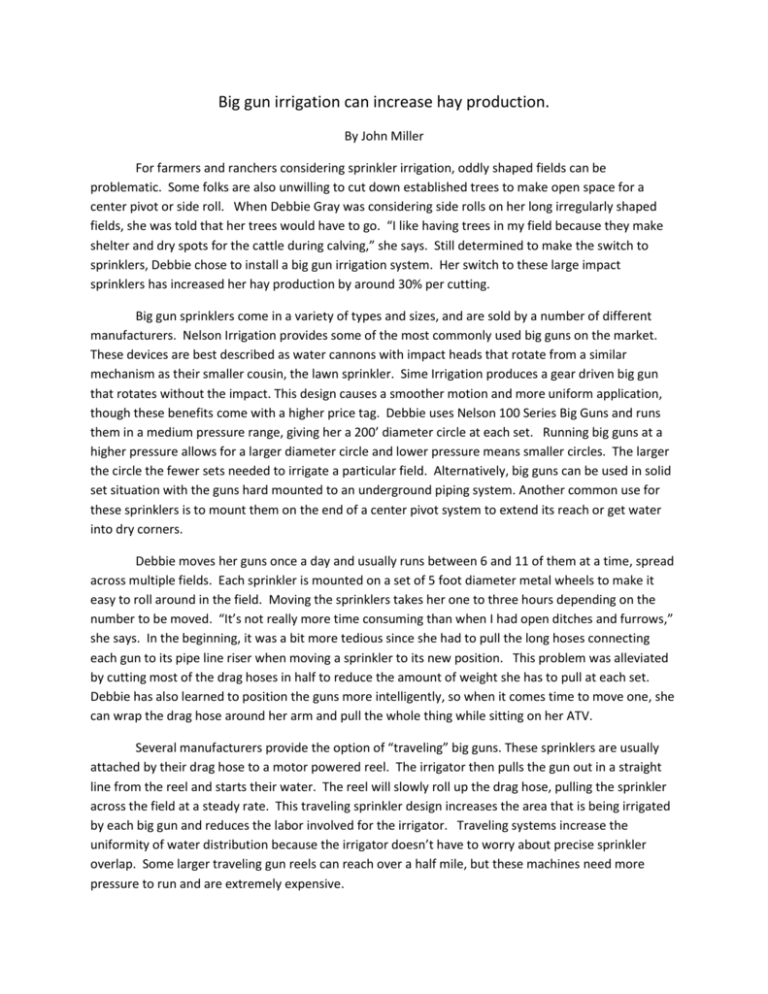
Big gun irrigation can increase hay production. By John Miller For farmers and ranchers considering sprinkler irrigation, oddly shaped fields can be problematic. Some folks are also unwilling to cut down established trees to make open space for a center pivot or side roll. When Debbie Gray was considering side rolls on her long irregularly shaped fields, she was told that her trees would have to go. “I like having trees in my field because they make shelter and dry spots for the cattle during calving,” she says. Still determined to make the switch to sprinklers, Debbie chose to install a big gun irrigation system. Her switch to these large impact sprinklers has increased her hay production by around 30% per cutting. Big gun sprinklers come in a variety of types and sizes, and are sold by a number of different manufacturers. Nelson Irrigation provides some of the most commonly used big guns on the market. These devices are best described as water cannons with impact heads that rotate from a similar mechanism as their smaller cousin, the lawn sprinkler. Sime Irrigation produces a gear driven big gun that rotates without the impact. This design causes a smoother motion and more uniform application, though these benefits come with a higher price tag. Debbie uses Nelson 100 Series Big Guns and runs them in a medium pressure range, giving her a 200’ diameter circle at each set. Running big guns at a higher pressure allows for a larger diameter circle and lower pressure means smaller circles. The larger the circle the fewer sets needed to irrigate a particular field. Alternatively, big guns can be used in solid set situation with the guns hard mounted to an underground piping system. Another common use for these sprinklers is to mount them on the end of a center pivot system to extend its reach or get water into dry corners. Debbie moves her guns once a day and usually runs between 6 and 11 of them at a time, spread across multiple fields. Each sprinkler is mounted on a set of 5 foot diameter metal wheels to make it easy to roll around in the field. Moving the sprinklers takes her one to three hours depending on the number to be moved. “It’s not really more time consuming than when I had open ditches and furrows,” she says. In the beginning, it was a bit more tedious since she had to pull the long hoses connecting each gun to its pipe line riser when moving a sprinkler to its new position. This problem was alleviated by cutting most of the drag hoses in half to reduce the amount of weight she has to pull at each set. Debbie has also learned to position the guns more intelligently, so when it comes time to move one, she can wrap the drag hose around her arm and pull the whole thing while sitting on her ATV. Several manufacturers provide the option of “traveling” big guns. These sprinklers are usually attached by their drag hose to a motor powered reel. The irrigator then pulls the gun out in a straight line from the reel and starts their water. The reel will slowly roll up the drag hose, pulling the sprinkler across the field at a steady rate. This traveling sprinkler design increases the area that is being irrigated by each big gun and reduces the labor involved for the irrigator. Traveling systems increase the uniformity of water distribution because the irrigator doesn’t have to worry about precise sprinkler overlap. Some larger traveling gun reels can reach over a half mile, but these machines need more pressure to run and are extremely expensive. Debbie is considering replanting one of her fields for the 2015 season and is looking forward to not having to deal with furrows in her fields. In order to get water to some dry spots, furrows can get deep and she feels that they are “hard on haying equipment.” Re-marking fields in the spring can also be time consuming. It takes 0.5 cubic feet per second to provide enough water for six of the guns at Debbie’s ranch. She has irrigated this ground in the Leroux Creek area for over thirty years, and with her short water season, she struggles to get a second cutting each year. This year she is on track for a decent second cutting, and says the hay is “thicker because of the sprinklers.” She remarks that with the old flood irrigation system she had a lot of tail water. “There is a little runoff now, but it’s not much. The guns definitely make my limited water go much farther. I would do it again,” she says. Indeed, as our interview draws to a close we spend the remainder of our time contemplating how easy it would be to extend her big gun system to her other fields. This article is the third article in a six part series on different types of irrigation systems, and was written by John Miller, Irrigation Water Management Specialist, who can be reached at 874-5726 ext. 119 if you have questions about optimization of your current irrigation system. The Delta office of the NRCS (Natural Resource Conservation Service) and DCD (Delta Conservation District) can provide you with resources and assistance to upgrade your irrigation system. Some system upgrades may qualify for financial assistance through the EQIP or BSP programs. The NRCS and DCD can be reached at (970)8745726 or you can stop by the office at 690 Industrial Blvd. in Delta Colorado.
